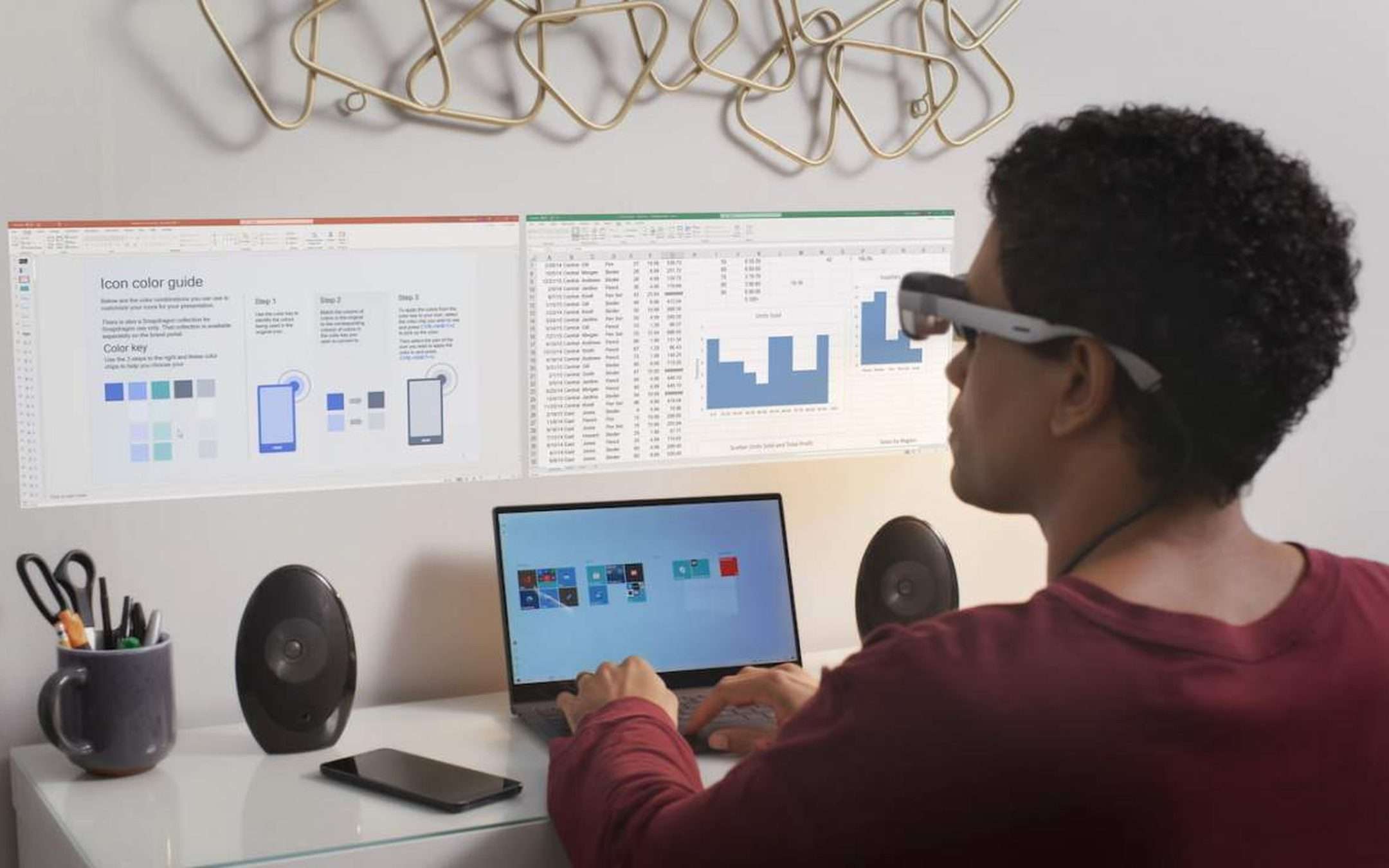
Qualcomm XR1 Smart Viewer
Qualcomm has announced a new reference design for AR (augmented reality) glasses aimed at businesses. The Snapdragon XR1 Smart Viewer can be connected to compatible smartphones or a Windows computer via USB Type-C port. The first commercial product is Lenovo ThinkReality A3, but more will hit the market in the coming months.Snapdragon XR1 AR Smart Viewer
Qualcomm has already unveiled two reference designs based on the XR1 and XR2 platforms, but these are glasses for mixed reality (virtual and augmented). The new Snapdragon XR1 AR Smart Viewer is instead purely indicated for augmented reality and has been designed to perform some operations with integrated components, while for others an external device (smartphone or PC) is used.This has made it possible to reduce size and weight (in fact they are very similar to traditional glasses), as well as consumption up to 30% compared to “all-in-one” models. As can be seen in the image and video, the glasses can display multiple virtual screens.
The 8 megapixel RGB camera with image stabilization allows for remote assistance, while two monochrome cameras allow for head tracking with six degrees of freedom and hands with gesture recognition.
The Snapdragon XR1 AR Smart Viewer integrates two micro-OLED screens (made by BOE) with full HD resolution (1920 × 1080 pixels) and refresh rate of 90 Hz. Qualcomm's glasses will serve as a benchmark for commercial product development.
Source: Qualcomm
Qualcomm launches XR1 AR Smart Viewer platform
Qualcomm has launched its latest augmented reality (AR) prototype platform based on the Qualcomm Snapdragon XR1 platform.
The platform provides hardware developers with all of the tools they need to deliver a high-performance, immersive experience in a headset or smart glasses device that consumes low amounts of power.
The XR1 AR Smart Viewer reference design (which customers use to create their hardware products) lets customers create their own augmented reality (AR) smart viewer. Based on the design, consumers and enterprise users will be able to wear the AR glasses and plug them into a smartphone, Windows PC, or another Qualcomm Snapdragon device to tap more computing power or battery power.
The AR smart viewer has processing in the reference design to help distribute computing workloads between the viewer and the host device, compared to an AR simple viewer that does not have any processing on the viewer. The AR smart viewer reference design packs significant performance features and premium use cases for both the enterprise and consumers, Qualcomm VP Hugo Swart said in a press briefing. What’s different now is the ability to put some processing into the glasses.
I listened to Swart talk about this while inside Spatial’s mixed-reality app. I logged in via my smartphone and then joined the press briefing in virtual reality using an Oculus Quest 2 VR headset. Swart showed slides on a screen inside the virtual room, and he took questions from journalists who were inside the space as virtual avatars.

Above: Qualcomm’s XR1 AR Smart Viewer reference design.
Image Credit: Qualcomm
The platform has split processing, with some of that computation happening in the glasses themselves and some on the device, which is connected to the glasses via a wire. This design helps keep the glasses small and comfortable, but it also brings computing power to the device, Swart said.
The 2D app framework provides a systems-level feature that helps launch smartphone applications into multiple virtual displays that can be anchored within the user’s AR simple viewer. It is compatible with select smartphones, host processing pucks, and PCs, including but not limited to devices powered by the Qualcomm Snapdragon Platform’s 800 series processors.
The framework also supports protected content viewing to watch premium movies and streaming services with the smart viewer. Users will be able to tether to a PC, and the smart viewer combines plane detection and the ability to render multiple virtual displays to allow virtual PC windows to be anchored to planes in the real world.

Above: You can plug smart viewer AR glasses into other devices.
Image Credit: Qualcomm
“We believe that standalone, all-in-one devices will continue to evolve, will continue to get better, smaller,” Swart said. “But there’s also a market for AR connected to devices that we already use. So it’s not that we think it’s one or the other.”
Microsoft said it will bring its Azure MR services to the Snapdragon mixed-reality ecosystem. Lenovo also recently unveiled its ThinkReality A3 — powered by the Snapdragon XR1 Platform. Lenovo is targeting its smart glasses device at the enterprise with a launch in mid-2021. Nreal has also embraced the platform with its latest smart glasses products.
“We want this reference design to be the catalyst for these smart viewers that our customers will commercialize, will make available to the end consumer and enterprises based on the XR1,” Swart said. “It’s an AR smart viewer reference design. The benefits of smart viewers include low power, as you get a 30% reduction in system power when you go from a simple viewer to a smart viewer.”
He added, “You can now run more data concurrently, enable hand tracking and eye tracking, and run with richer graphics. It makes the experience more immersive. We’ve also built for multiple types of hosts, from 5G phones to PCs.”
GamesBeatGamesBeat's creed when covering the game industry is 'where passion meets business.' What does this mean? We want to tell you how the news matters to you -- not just as a decision-maker at a game studio, but also as a fan of games. Whether you read our articles, listen to our podcasts, or watch our videos, GamesBeat will help you learn about the industry and enjoy engaging with it. How will you do that? Membership includes access to: